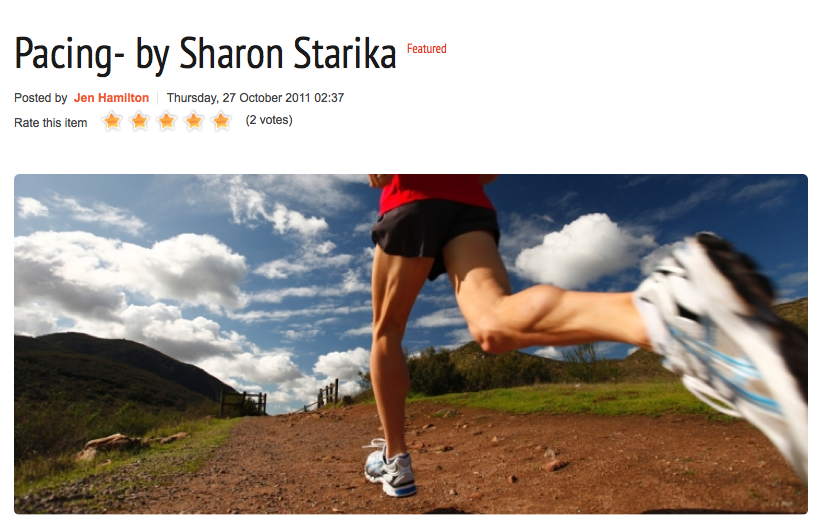What is pacing? Read this article featured on TriEdge.net to learn how pacing can improve your running.
What is pacing, really? And how does someone learn to pace when running? Learning to pace may not only be the key to a faster run, but a faster run with less effort. A concept we can all appreciate. When I think of pacing, I immediately think of breathing.
Breathing is such an interesting topic, and there has been much discussion on the right way to breathe. What I’ve learned from The Feldenkrais Method, which is the Method I teach, is that breathing is the one thing that is truly wired into us as human beings. We are an advanced mammal and there are many things we must learn however, breathing is not one of them. Breathing occurs automatically. In saying this, it is in the how we are breathing or perhaps not breathing and our ability to self-regulate our breathing, which allows us to breathe in a rhythmic, smooth, effortless way. Our environment (i.e. what we are doing) plays a large part in how we breathe as well. So if we are sitting watching T. V., our breathing is much quieter than if were running. What about swimming for those of you who are triathletes? Have you ever noticed how your breathing is completely different when swimming than running and you never think about it do you? Because we self-regulate. But often there is tension around our self-regulation, therefore, dramatically affecting our ability to carry out the action or sport we are doing.
So how does one find their pace, their rhythm, and their breath? How does one self-regulate? First and foremost I believe it is crucial to start your run off slow. Allowing yourself to warm up gives you time to get into a rhythm for yourself. If you start off to fast you may miss this opportunity to notice. Once you are running for a few minutes you begin to listen; listen to your inner self, not your head/ your thoughts, the traffic, or your headphones. You can have that all going on, but you learn to draw your attention inward and feel your breath. Ask yourself, “How is my breathing?” Notice if anything is feeling difficult including your breathing. Once you draw awareness, you will notice.
Awareness is the first step and the key ingredient to finding your rhythm, finding your pace. Is your breath fast? Is it choppy, is it rushed? Are you exhaling? Which by the way is critical because it is automatic to inhale. Continue to ask, are my legs heavy, do they feel tired, and do I feel tired? It is important to ask these questions for if any part of you is working too hard, it will directly affect your breathing.
So now what do you do? Once you become aware, the great news is, change is already happening. This is why awareness is so important. Now you have the option to either shift your pace to slow down so you can regulate your choppy breathing to a smoother breath, or you can slow your pace to allow your legs to feel lighter and less heavy. So you have options to start self –regulating. I personally choose to shift my breathing. I find if I slow my pace down just a little I allow my breath to become fluid, rhythmic and smooth. Once this has happened, I find everything in my running becomes lighter, easier, smoother and more free. My whole system has self-regulated. I continue to notice the shift staying there for a few minutes before I increase my speed. I allow myself the time to adapt to the new effortless pace. So as you pick up the pace, your breathing will become faster, and faster is okay as long as your breathing is smooth and continuous. Then I look for the next moment when I feel so at ease with my pace and my breathing that I know I can increase my speed again. I add the increase, and return to noticing my breathing and rhythm. Can I keep the quality of breathing with this new increase of speed? The answer must be yes to be able to run with ease, if the answer is no, I must back off a bit.
Over the years my ability to self-regulate is quite natural and very quick. Practicing such self-regulation has led me to not only find a great sense of ease in my runs, but with the ease a faster pace that I can sustain for long runs. I may self-regulate 10 times over the course of a 20 mile run. It doesn’t matter how often, what does matter is the ability to notice so you can shift yourself. You should also notice where you are placing effort. I’ll shift my attention to all different areas; my feet, my legs, my shoulders, my arms, just asking the inner question: “How does this part of me feel right now?” Again, as you notice, change is in the works.
Hopefully these tips will help you become even more self aware. My hope is, through such self awareness you will develop a deep inner connection with yourself, thus being able to self-regulate giving yourself the best runs ever!



Recent Articles